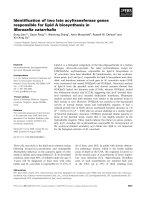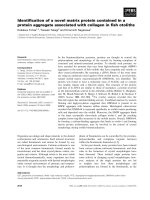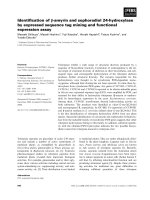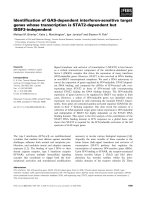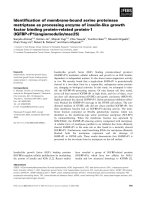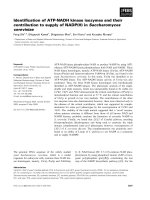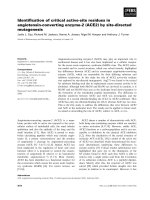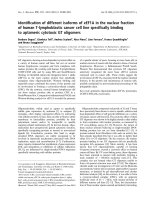Báo cáo khoa học: Identification of preferred substrate sequences for transglutaminase 1 – development of a novel peptide that can efficiently detect cross-linking enzyme activity in the skin pot
Bạn đang xem bản rút gọn của tài liệu. Xem và tải ngay bản đầy đủ của tài liệu tại đây (477.1 KB, 11 trang )
Identification of preferred substrate sequences for
transglutaminase 1 – development of a novel peptide
that can efficiently detect cross-linking enzyme
activity in the skin
Yoshiaki Sugimura1,*, Masayo Hosono1,*, Miyako Kitamura1, Tatsuya Tsuda2, Kiyofumi
Yamanishi2, Masatoshi Maki1 and Kiyotaka Hitomi1
1 Department of Applied Molecular Biosciences, Graduate School of Bioagricultural Sciences, Nagoya University, Japan
2 Department of Dermatology, Hyogo College of Medicine, Nishinomiya, Japan
Keywords
epidermis; keratinocyte; phage display; skin;
transglutaminase
Correspondence
K. Hitomi, Department of Applied Molecular
Biosciences, Graduate School of
Bioagricultural Sciences, Nagoya University,
Chikusa, 464 8601 Nagoya, Japan
Fax: +81 52 789 5542
Tel: +81 52 789 5541
E-mail:
*These authors contributed equally to this
work
(Received 1 August 2008, revised
10 September 2008, accepted
18 September 2008)
doi:10.1111/j.1742-4658.2008.06692.x
Transglutaminase 1 (TGase 1) is an essential enzyme for cornified envelope formation in stratified squamous epithelia. This enzyme catalyzes
the cross-linking of glutamine and lysine residues in structural proteins
in differentiating keratinocytes. To gain insight into the preferred
substrate structure of TGase 1, we used a phage-displayed random
peptide library to screen primary amino acid sequences that are
preferentially selected by human TGase 1. The peptides selected as glutamine donor substrate exhibited a marked tendency in primary structure,
conforming to the sequence: QxK ⁄ RwxxxWP (where x and w represent
non-conserved and hydrophobic amino acids, respectively). Using glutathione S-transferase (GST) fusion proteins of the selected peptides, we
identified several sequences as preferred substrates and confirmed that
they were isozyme-specific. We generated GST-fused alanine mutants of
the most reactive sequence (K5) to determine the residues that were critical for reactivity. Even in peptide form, K5 appeared to have high and
specific reactivity as substrate. In situ analysis of mouse skin sections
using fluorescence-conjugated K5 peptide resulted in detection of
TGase 1 activity with high sensitivity, but no signal was detected in a
TGase 1-null mouse. In conclusion, we were successful in generating a
novel substrate peptide for sensitive detection of endogenous TGase 1
activity in the skin.
Transglutaminase (TGase; EC 2.3.2.13) is a Ca2+dependent enzyme that catalyzes the formation of
isopeptide cross-links between the c-carboxyamide
group of glutamine residues and the e-amino group of
lysine residues [1,2]. In addition, TGases catalyze the
incorporation of primary amines into glutamine residues (transamidation), or conversion of glutamine to
glutamic acid (deamidation). TGases comprise a family
of eight isozymes (Factor XIII and TGases 1–7) that
are distributed in a variety of tissues and have unique
substrate specificities. Factor XIII and TGase 2 (tissuetype TGase), two of the major isozymes, are involved
in the stabilization of fibrin clots, and in apoptosis,
extracellular matrix stabilization and wound healing,
respectively [3–6]. TGase 1 is expressed primarily in
epithelial cells and plays an essential role in formation
of the skin epidermis [7–9].
In the outermost layer of the epidermis, the assembly
of a highly specialized structure, termed the cornified
envelope (CE), is formed as a result of cross-linking of
Abbreviations
Bio-Cd, 5-(biotinamido)pentylamine; CE, cornified envelope; Dansyl-Cd, monodansylpentylamine; FITC, fluorescein isothiocyanate; GST,
glutathione S-transferase; TGase, transglutaminase.
FEBS Journal 275 (2008) 5667–5677 ª 2008 The Authors Journal compilation ª 2008 FEBS
5667
Preferred substrate sequences for TGase 1
Y. Sugimura et al.
several structural proteins in keratinocytes [10–12]. The
CE is located underneath the plasma membrane of differentiated keratinocytes and is essential for barrier
function of the epidermis. The CE comprises several
proteins, including involucrin, loricrin, trichohyalin and
small proline rich-proteins, that are preferred substrates
for TGases in the skin. Of the eight TGase isozymes,
four (TGases 1, 2, 3 and 5) are expressed in keratinocytes [13–18], and are involved in cross-linking of the
structural proteins to form the CE at distinct intracellular sites [8,18]. In the current model of TGase function,
cytoplasmic TGase 3 catalyzes the cross-linking of
several proteins, and these products are then stabilized
with a proteinaceous platform beneath the plasma
membrane, which is formed by membrane-anchored
TGase 1 [19]. However, the precise mechanism by
which these enzymes coordinate the cross-linking of
various substrates is poorly understood. Mice that lack
TGase 1 exhibit impaired skin barrier function due to
aberrant cornification [20]. In humans, several types of
TGase 1 mutations have been identified in congenital
ichthyoses, such as non-bullous congenital ichthyosiform erythroderma and lamellar ichthyosis [21–25].
Thus, TGase 1 appears to be an essential and
non-redundant enzyme for CE formation in the epidermis under functional regulation [26].
Generally, TGases display strict substrate specificity
towards peptide-bound glutamine residues and relatively weak specificity with respect to lysine residues or
amine groups. Hence, information about the primary
and ⁄ or secondary structure of sequences surrounding
the reactive glutamine residue in substrates is important for understanding substrate specificity in TGasemediated catalysis [27]. Partial amino acid sequences
of substrates for TGase 2 and Factor XIII have been
identified [28]. Although several protein substrates for
TGase 1 have been characterized, a consensus
sequence for the preferred substrate has not been identified [29–32].
Recently, we established a system for the identification of preferred substrate sequences of TGases by
screening a phage-displayed random peptide library
[33,34]. Using this system, we identified the primary
sequences of the various preferred, isozyme-specific
substrates of TGase 2 and Factor XIII. These results
provide new insight into the substrate specificity of
TGases, and expand the range of application using the
enzyme reactions [35].
In the current study, we used this system to identify
preferred TGase 1-specific peptide sequences. We identified several sequences that were preferentially selected
by human TGase 1 and exhibited a significant
tendency to serve as glutamine donor substrates. One
5668
peptide, K5, exhibited strong activity in both recombinant fusion protein and peptide forms. Using this peptide, we were able to detect in situ TGase 1 activity in
mouse skin sections with a high level of sensitivity and
specificity.
Results
Screening of candidate substrate sequences from
a random peptide library
In the presence of recombinant human TGase 1, phage
clones were incubated with biotin-labeled primary
amine (Bio-Cd). Phage clones that were covalently
bound to Bio-Cd were selected by avidin affinity purification. The selected clones were amplified and then
subjected to four additional cycles of catalysis and
panning as described previously [33]. Sequence analysis
of the peptides encoded by the final clones revealed
that 32 of the 56 clones contained glutamine residues
(Fig. 1). When the peptides were aligned based on the
putative reactive glutamine residue, there were several
significant similarities among the primary sequences of
more than half of the clones: (1) tyrosine and glutamine were located at the N-terminus of the peptide, (2)
there was a lysine or an arginine at position +2 (relative to glutamine), (3) a hydrophobic amino acid was
commonly observed at position +3, and (4) tryptophan and proline were frequently located at positions
+7 and +8, respectively.
Among the clones, there was one frequently
observed sequence (YEQHKLSSWPF) that was
encoded by identical DNA sequences, but treated as
an individual clone.
Evaluation of the selected sequences as
recombinant peptide-fused GST proteins
To evaluate the ability of the selected peptide sequences
to serve as glutamine donor substrates, we measured
the amount of monodansyl cadaverine (Dansyl-Cd)
incorporated into recombinant peptide–GST(QN)
fusion proteins (in which all the glutamine residues in
glutathione S-transferase (GST) had been changed to
asparagine) in the presence of TGase 1. The sequences
marked with an asterisk in Fig. 1 were selected for
analysis. The reaction products were separated by
SDS–PAGE and then visualized by UV illumination
(Fig. 2).
GST(QN) fusion proteins of the K1, K2, K5, K13,
K26, K51, K57 and K60 sequences exhibited significant levels of incorporation of Dansyl-Cd compared
to the other sequences examined. All of the highly
FEBS Journal 275 (2008) 5667–5677 ª 2008 The Authors Journal compilation ª 2008 FEBS
Y. Sugimura et al.
Preferred substrate sequences for TGase 1
Fig. 1. Alignment of candidate substrate peptide sequences. Amino acid sequences of the peptides contained within the selected phage
clones were aligned based on the putative reactive glutamine residues. The glutamine residues, the hydrophobic amino acids at position +3
(relative to glutamine), and the most commonly observed amino acids are shaded. Clones marked with an asterisk were evaluated as
GST(QN) fusion proteins using the Dansyl-Cd incorporation assay.
reactive sequences had the similarities described above,
which suggested that our procedure was successful in
identifying the preferred sequences. Of these highly
reactive sequences, we selected K5, K26, K51 and K60
for further analysis based on their levels of reactivity.
Isozyme specificity of the peptide sequences
The four sequences with the highest reactivity were
further analyzed for isozyme specificity with respect to
TGases 1, 2 and 3, and Factor XIIIa (activated Factor XIII). GST(QN) fusion proteins of each peptide
were incubated with [3H]-putrescine in the presence of
each TGase. Most of the peptide sequences exhibited
high reactivity with TGase 1, consistent with the
results of the Dansyl-Cd incorporation assay (Fig. 3).
We did not observe cross-reactivity for any of the
peptides, with the exception of K60, which showed significant incorporation in the presence of Factor XIIIa.
K5 exhibited the lowest cross-reactivity to TGases 2
and 3, indicating the highest specificity. Thus, we
selected K5 for further analysis.
Substitution mutant analysis of the K5 peptide
sequence
To determine the role of each amino acid of K5 in
TGase 1-mediated catalysis, we generated alanine
substitution mutants for every residue of the
12-amino-acid peptide. Wild-type and mutant peptides
were produced as GST(QN) fusion proteins, and evaluated for their reactivity in the presence of TGase 1.
As shown in Fig. 4, mutation of positions +2 (K), +3
(L), +5 (S), +6 (S), +7 (W), +8 (P) or +9 (F) to
alanine decreased the level of incorporation of DansylCd. Substitutions at positions )2 (Y), )1 (E), +1 (H)
or +4 (P) had a smaller effect on the reactivity of the
peptide.
Assessment of the K5 sequence for reactivity
and specificity in the peptide form
To assess the reactivity and specificity of K5 in the
peptide form, biotinylated K5 (pepK5: YEQHK
LPSSWPF), or K5 in which the reactive glutamine
residue was replaced by asparagine (pepK5QN:
YENHKLPSSWPF), were incubated with casein as a
glutamine acceptor substrate in the presence of TGases
1, 2 or 3. For comparison, we also examined the reactivity of the TGase 2 preferred substrate peptide
(pepT26: HQSYVDPWMLDH) [33]. Incorporation of
pepK5 into casein was observed in the presence of
TGase 1 in a time-dependent manner, but pepT26
showed no apparent reactivity (Fig. 5A). In contrast,
in the presence of TGase 2, pepT26 showed apparent
incorporation into casein, whereas pepK5 reacted at
FEBS Journal 275 (2008) 5667–5677 ª 2008 The Authors Journal compilation ª 2008 FEBS
5669
Preferred substrate sequences for TGase 1
CBB
0 0.5 1
2
Y. Sugimura et al.
5 10 15 20 (min)
DMC
Ctrl
K1
K2
K5
Detection of in situ TGase 1 activity in skin
K13
K26
K51
K57
K60
K11
K29
K42
K56
K59
K70
Fig. 2. Evaluation of the reactivity of selected peptides as peptide
GST fusion proteins. Incorporation of Dansyl-Cd into peptide–
GST(QN) fusion proteins of the selected amino acid sequences in
the presence of TGase 1. The numbers prefixed with K (K1, K2, K5,
etc.) for each peptide sequence correspond to the ID numbers of
the clones (Fig. 1). At the indicated times, the reaction products
were separated by 12.5% SDS–PAGE and then illuminated by UV
light. Unreacted (0 min) peptide–GST(QN) fusion proteins were
stained with Coomassie brilliant blue and are shown on the left
of the fluorograph. Ctrl, GST(QN) fusion protein of a peptide that
does not contain a glutamine residue (K3, SPLAYVAPWSNL).
Dimethylcasein (DMC) was examined in parallel as a positive control.
much lower level (Fig. 5B). However, at a higher concentration of the peptide (above 0.1 mm), pepK5
showed cross-reactivity to TGase 2 (data not shown).
pepK5QN was not incorporated into casein, also acting as glutamine-donor substrate, in the presence of
either TGase 1 or TGase 2. This result indicates that
the lysine residue in the sequence of K5 does not
participate in the enzymatic reaction.
To determine whether K5 cross-reacts with TGase 3,
we compared the incorporation rates of pepK5 in the
presence of TGases 1 or 3, as a preferred peptide
sequence for TGase 3 has not yet been established
(Fig. 5C). In the presence of TGase 3, the incorporation of pepK5 was similar to control reactions that did
5670
not contain any enzyme, whereas there was a significant increase in incorporation in the presence of
TGase 1. pepK5QN also failed to react with casein in
the presence of TGase 3 (data not shown). These
results indicate that the K5 peptide sequence acts as a
glutamine donor substrate in an isozyme-specific
manner, even in the peptide form.
As pepK5 appeared to be a highly preferred and specific substrate for TGase 1, we examined whether this
peptide could be used to detect endogenous TGase 1
activity in the skin epidermis (Fig. 6A). In the presence
of CaCl2 in the reaction mixture, we detected specific
incorporation of fluorescein isothiocyanate (FITC)labeled K5 peptide (FITC-pepK5) (1 lm) into substrate proteins in the epidermis, mainly at the cell
periphery of the upper spinous and granular layers.
This staining pattern of reactivity corresponded well
with the localization of TGase 1 by immunostaining
with monoclonal anti-mouse IgG. No signals were
detected when we used FITC-pepK5QN mutant peptide, or in the presence of EDTA, which indicated that
the cross-linking reaction was catalyzed specifically by
TGase 1. To further evaluate the specificity of the
assay for TGase 1, skin sections from a TGase 1
knockout mouse were also examined. No signals were
detected in TGase 1-null sections in the presence or
absence of Ca2+, which indicates that FITC-pepK5
specifically detects endogenous TGase 1 activity.
We also compared the reactivity of FITC-pepK5
and FITC-cadaverine, which has been used previously
for detection of in situ TGase activity, over a range of
concentrations (0.1–100 lm). As shown in Fig. 6B,
endogenous TGase 1 activity was detected at 0.1–1 lm
FITC-pepK5, but no apparent signal was observed
with FITC-cadaverine at the same concentrations. In
the presence of higher concentrations of cadaverine,
the staining pattern became somewhat ambiguous in
mouse skin sections, possibly because of cross-reactivity with other TGases. These results suggest that
FITC-pepK5 detects endogenous TGase 1 activity with
greater sensitivity than FITC-cadaverine.
Discussion
In terminally differentiating stratified epithelial cells,
isopeptide cross-linking of keratinocyte proteins into
organized protein structures lead to the formation of
the CE. Although the cooperative action of several
TGases in the keratinocytes plays a role in this process, the precise role of each isozyme in cross-linking
FEBS Journal 275 (2008) 5667–5677 ª 2008 The Authors Journal compilation ª 2008 FEBS
10
9
8
7
6
5
4
3
2
1
DMC
Ctrl
K5
K26
K51
K60
DMC
Ctrl
K5
K26
K51
K60
DMC
Ctrl
K5
K26
K51
K60
0
DMC
Ctrl
K5
K26
K51
K60
Fig. 3. Cross-reactivity of the preferred
sequences with TGase 2, TGase 3 and
Factor XIIIa. GST(QN) fusion proteins of
peptides K5, K26, K51 and K60, and the
control sequence (WGHTIYHLHPTI [33])
(Ctrl), were incubated for 10 min with
1.0 mM [3H]-putrescine in the presence of
TGase 1, TGase 2, TGase 3 or Factor XIIIa.
Dimethylcasein (DMC) was used in parallel
to adjust the enzymatic activities. Data are
the means ± SD of triplicate assays.
Preferred substrate sequences for TGase 1
[3H]-putrescine incorporated (×104 dpm)
×
Y. Sugimura et al.
TGase 1
TGase 2
TGase 3
Factor XIIIa
1.4
Relative value
1.2
1
0.8
0.6
0.4
0.2
0
WT –2A –1A QN +1A +2A +3A +4A +5A +6A +7A +8A +9A
Fig. 4. Assessment of the contribution of each amino acid residue
of K5 to substrate recognition. Alanine substitution mutants of K5
were produced as GST(QN) fusion proteins, and then incubated
with Dansyl-Cd for 10 min in the presence of TGase 1. The reaction
products were separated by SDS–PAGE, followed by UV irradiation.
The fluorescence intensity was analyzed by SCION imaging software for quantification. The relative values shown are normalized to
the intensity for the reaction of wild-type. Data represent the
means of duplicate samples. Numbers ()2A to +9A) indicate the
position of substitution mutations. WT, peptide in which there were
no amino acid substitutions; QN, peptide in which the glutamine
residue was changed to asparagine. The mutations that resulted in
an apparent decrease in the reactivity are shaded in darker gray.
of the target substrates remains elusive. TGase 1 has
unique substrate specificity, which results in a distinct
pattern of in vitro cross-linked substrate proteins compared to other TGases [32,36,37]. A better understanding of the preferred substrate structure for TGase 1 is
essential to evaluate substrate reactivity, and also to
develop isozyme-specific regulatory molecules.
In the current study, preferred substrate sequences
for TGase 1 selected through screening of a phage-displayed peptide library exhibited different tendencies
compared to those for Factor XIIIa and TGase 2
[33,38]. The preferred substrate sequence for TGase 1
conformed to the consensus motif QxR ⁄ KwxxxWP,
whereas those for TGase 2 and Factor XIIIa conform
to the motifs QxPwDP and QxxwxWP, respectively. A
hydrophobic amino acid at +3 relative to the glutamine residue is present in the substrate motifs of all
three TGases. Based on previous studies, the preferred
sequence for TGase 2 contains the sequence QxP,
which has been shown to be an in vivo transamidation
motif [39]. In the case of TGase 1, most of the selected
substrates contained QxK or QxR. This motif is frequently observed in involucrin, trichohyalin and small
proline-rich proteins, and has been implicated as a
putative cross-linking site in these proteins [32,36,37].
Sequences homologous to the motif QxR ⁄ KwxxxWP
are present in the C-terminal regions of involucrin
(QQKQEVQWP) and loricrin (QQKQAPTWP), which
are the main components of the CE. In the developing
TGase substrate database (TRANSDAB; http://
genomics.dote.hu/wiki), several sequences containing
the reactive glutamine residue have been listed for
TGase 1 as well as other isozymes. When these
sequences were compared with our proposed consensus
sequence, half of the sequences were found to contain
QxK or QxxK, which is partially consistent with the
obtained motif.
Interestingly, the TGase 1 substrate motif was similar to that of Factor XIIIa, QxxwxWP. Among TGase
family members, the primary structures of Factor XIII
and TGase 1 display the most homology, which suggests that the catalytic domains of these two enzymes
may recognize similar substrate structures.
Most of the highly reactive peptide sequences identified in this study (K1, K2, K5, K26, K57 and K60)
contained the TGase 1 substrate consensus sequence.
The peptide sequences K5, K26 and K51 exhibited less
FEBS Journal 275 (2008) 5667–5677 ª 2008 The Authors Journal compilation ª 2008 FEBS
5671
Preferred substrate sequences for TGase 1
Absorbance at 492 nm
A 1.2
Y. Sugimura et al.
TGase 1
1
0.8
0.6
0.4
K5
K5QN
T26
0.2
0
0
5
10
15
20
25
Reaction time (min)
Absorbance at 492 nm
B 1.2
TGase 2
1
0.8
0.6
0.4
K5
K5QN
T26
0.2
0
0
5
10
15
20
Reaction time (min)
25
C 1.2
Absorbance at 492 nm
1
0.8
0.6
0.4
TGase 1
TGase 3
-TGase
0.2
0
0
10
20
Reaction time (min)
30
Fig. 5. Analysis of the reactivity of the K5 peptide with casein in
the presence of TGases. The time-dependent incorporation of biotinylated peptides (pepK5, pepK5QN and pepT26) into casein was
examined in the presence of TGase 1 (A) and TGase 2 (B). The
amount of reaction product was determined by microtiter assay,
and is represented as absorbance at 492 nm. The square, circle
and triangle represent pepK5, pepK5QN and pepT26, respectively.
(C) Time-dependent incorporation of pepK5 measured in the presence of TGase 1 (closed circle) or TGase 3 (open circle). Reaction
mixtures that did not contain enzyme were analyzed in parallel (triangle) as a negative control. Data represent the means ± SD of
triplicate samples.
cross-reactivity with other TGases, and K60 exhibited
some reactivity towards Factor XIIIa. These results
indicate that the consensus motif identified in this
5672
study defines a unique structure of preferred substrates
of TGase 1. This information should be useful for predicting substrate reactivity and designing regulatory
molecules that can interact with the active site of the
enzyme.
K5 (YEQHKLPSSWPF) showed the highest level of
reactivity and specificity as a substrate for TGase 1. Of
note, the K5 sequence was the most frequently selected
clone during screening, which suggests that (a) this
sequence is a highly preferred substrate as compared
to other sequences, and ⁄ or (b) the phage clone that
contained this sequence was efficiently amplified in
bacteria.
Mutational analysis of each amino acid residue in
the K5 sequence demonstrated that the consensus
TGase 1 motif, as well as additional C-terminal amino
acids, is important in substrate activity. This was
expected because the other selected peptides had
conserved amino acid residues among analyzed
sequences. It would be interesting to explore whether
shorter peptides can function as substrates with similar
levels of reactivity.
The reactivity and specificity of K5 for TGase 1 was
maintained even in peptide form. Initially, we expected
that the lysine residue of K5 would react with the glutamine residue of pepK5 itself or with casein during
the catalytic reaction. However, pepK5QN, in which
the glutamine was mutated but lysine was not, failed
to react with casein (Fig. 2), which indicates that there
is no reactivity of K5 as a glutamine acceptor.
Although there is far less selectivity of TGase for glutamine acceptor substrates in general, this result indicates that the lysine residue in the pepK5 is not
strongly reactive. Thus, pepK5 represents a potentially
valuable tool for determining the specific partners that
are favored substrates during TGase 1 catalysis.
When we examined the ability of pepK5 to detect
endogenous TGase 1 activity in mouse skin sections
(Fig. 6), Ca2+-dependent incorporation of FITCpepK5 into glutamine acceptor substrates in keratinocytes was seen, and this activity was undetectable in
sections from TGase 1-null mice. As observed in
immunostaining analysis, TGase 1 protein localized to
the peripheral regions of the keratinocytes in the granular and upper spinous layers, consistent with previous
reports [40,41], and the K5-reactive proteins most
likely co-localize with TGase 1 at these sites. These
results indicate that the K5 peptide acts as a sensitive
and precise probe to detect in situ activity of endogenous TGase 1. In the current study, K5 did not exhibit
cross-reactivity to TGase 3, skin-specific TGase. In the
in vitro assay with TGase 2, K5 reacted to a small
extent at higher enzyme activity or higher peptide
FEBS Journal 275 (2008) 5667–5677 ª 2008 The Authors Journal compilation ª 2008 FEBS
Y. Sugimura et al.
Preferred substrate sequences for TGase 1
A
Fig. 6. Detection of in situ TGase 1 activity
in mouse skin sections. (A) FITC-labeled
peptides (1 lM), pepK5 (upper) or pepK5QN
(lower), were incubated with mouse skin
sections in the presence of CaCl2 or EDTA.
TGase 1 activity in skin sections from a
TGase 1 knockout mouse was also examined (right). Sections analyzed by immunostaining using monoclonal anti-mouse
TGase 1 IgG (TGase1 mAb) and by hematoxylin and eosin staining are also shown
(left columns). (B) Detection of TGase 1
activity in wild-type mouse skin sections
using increasing concentrations
(0.1–100 lM) of FITC-labeled pepK5 or
FITC-cadaverine. Scale bar = 50 lm.
B
concentration. However, in the skin sections, there was
no significant TGase 2 activity because FITC-labeled
T26 showed no signal (data not shown).
To date, detection of cross-linked TGase products
using tissue sections has utilized an FITC-labeled
primary amine (FITC-cadaverine) or FITC-labeled
substrate peptides [42,43]. The pattern of TGase activity that we observed was consistent with that seen
in the skin using FITC-cadaverine [42], although
cadaverine is not an isozyme-specific probe, and thus
detects total TGase activity in keratinocytes. However,
in our study, the sensitivity of K5 was approximately
100–1000 times higher than that of FITC-cadaverine
(Fig. 6B). Thus, the method that we have established
for the detection of TGase 1 exhibits superior specificity and reactivity.
TGase 1 expression is not limited to the skin epidermis. It is also expressed in the kidney, hair follicle and
liver [40,42]. However, the precise roles of TGase 1 in
these tissues are unknown. In addition, in the epithelial
cells, activated TGase 1 is concentrated at adherent
junctions, but the substrates and biological significance
of the enzyme are not fully resolved [40]. A specific
and sensitive detection probe, such as FITC-labeled
pepK5, would be useful for investigating the role of
TGase 1-mediated cross-linking reactions in keratinocytes and in other cells and tissues.
In ongoing experiments, we are attempting to characterize the reactivity and to identify the preferred
substrate sequences of other skin TGases, as our developed screening system is applicable to other TGases
[33,44]. Recombinant TGase 5 is poorly expressed as a
soluble active form [17,45], thus we could not examine
its reactivity in this study. However, it is unlikely that
the selected peptides cross-react with TGase 5, as there
was no obvious reactivity of FITC-pepK5 in skin sections from a TGase 1 knockout mouse. Furthermore,
the cross-linking products containing pepK5 localized
primarily at the periphery of the cell, which is distinct
from the location of TGase 5 [17,18].
In conclusion, we have identified several preferred
substrate sequences for TGase 1. Our findings provide
valuable insight into substrate specificity in the crosslinking processes of the epidermis, and possibly other
epithelial tissues as well. Specific and sensitive detection of TGase 1 activity using FITC-labeled K5
peptide could be used for clinical diagnosis of congenital ichthyoses. Additional studies, particularly
FEBS Journal 275 (2008) 5667–5677 ª 2008 The Authors Journal compilation ª 2008 FEBS
5673
Preferred substrate sequences for TGase 1
Y. Sugimura et al.
co-crystallization of TGase 1 with the K5 peptide, are
required to refine the TGase 1 reaction mechanism,
and to develop specific regulatory molecules.
Experimental procedures
Transglutaminases
Human recombinant TGases 1 and 3 were obtained by
expression and purification from baculovirus-infected insect
cells, as described previously [46,47]. For activation of
TGase 3, the zymogen was proteolyzed by treatment with
dispase. Guinea pig liver TGase 2 was kindly provided by
K. Ikura (Graduate School of Science and Technology,
Kyoto Institute of Technology, Japan) [48]. Human Factor
XIII (FibrogamminÒ P; ZLB Behring, Marburg, Germany)
was activated to Factor XIIIa by treatment with bovine
thrombin (Sigma, St Louis, MO, USA).
Screening of a phage-displayed peptide library
Screening was carried out as previously described, using an
M13 Ph.D.-12 phage-display system (New England Biolabs
Inc., Ipswich, MA, USA) [33]. Briefly, approximately
1.5 · 1011 (1st round panning) or 1 · 1012)13 (2nd to 5th
round panning) phage clones were incubated at 37 °C with
TGase 1 (10 ngỈlL)1) in 10 mm Tris ⁄ HCl pH 8.0, 150 mm
NaCl ⁄ Tris buffer containing 1 mm dithiothreitol, 5 mm
CaCl2 and 5 mm Bio-Cd [EZ-linkÔ 5-(biotinamido)pentylamine] (Pierce Biotechnology, Rockford, IL, USA). After
termination of the catalytic reaction by addition of EDTA,
the phage particles were precipitated in the presence of polyethyleneglycol and NaCl with salmon sperm DNA as a
carrier. Next, the phage clones that covalently incorporated
Bio-Cd were selected by affinity chromatography using
mono-avidin gel (SoftLinkÔ soft release avidin resin; Promega Corp., Madison, WI, USA). After washing for 3 min
with NaCl ⁄ Tris containing 0.1% Tween-20 and 2 mm
EDTA and then with NaCl ⁄ Tris twice, the bound phage
particles were eluted by NaCl ⁄ Tris containing 5 mm biotin.
The entire eluate was used to infect Escherichia coli ER2738
host bacteria to amplify the phage. The phage particles were
concentrated by precipitation with polyethyleneglycol–NaCl
and then used for subsequent rounds of amplification. After
panning five times in all, the DNA sequences of the peptides
in the selected phage clones were determined.
Construction of the expression vector for GST
fusion proteins
The vector plasmid pET24d-GST(QN) was used to express
modified GST in which all the glutamine residues had been
substituted by asparagine residues, fused to a peptide at the
N-terminus [33]. The DNA of each phage was isolated, and
5674
the sequences of the 12-mer peptides were amplified by
PCR. Amplified PCR products were digested and inserted
into pET24d-GST(QN). For generation of peptide mutants
in which each amino acid was substituted by alanine or
asparagine, PCR-based mutagenesis was carried out.
Either E. coli BL21(DE3)LysS or BL21(DE3)LysE were
transformed with expression plasmids, and expression in
bacteria was induced by the addition of isopropyl b-d-thiogalactoside. Recombinant proteins were purified using
TALON metal affinity resin according to the manufacturer’s instructions (BD Biosciences, San Jose, CA, USA).
The concentration of the purified protein was determined
by the Bradford method (Bio-Rad Laboratories Inc.,
Hercules, CA, USA).
Evaluation of preferred sequences using
recombinant proteins
The reactivities of recombinant GST(QN) fusion proteins
were evaluated by incorporation of Dansyl-Cd (Sigma), a
fluorescence-labeled pentylamine. Recombinant protein
(200 ngỈlL)1) and 0.5 mm Dansyl-Cd were incubated in
NaCl ⁄ Tris buffer containing 5 mm CaCl2 and 1 mm dithiothreitol in the presence of TGase 1 (0.75 ngỈlL)1). Dimethylcasein (200 ngỈlL)1) was used as a positive control.
The reaction mixture was incubated at 37 °C and then separated by 12.5% SDS–PAGE. A fluorograph of the gel was
obtained by UV irradiation (254 nm) to visualize the
amount of incorporated Dansyl-Cd. To quantify the results,
the fluorescence intensity of each product was analyzed
using scion imaging software (Scion Corp., Frederick, MD,
USA).
For incorporation of radiolabeled putrescine, [3H]-putrescine (1.0 mm) was incubated in NaCl ⁄ Tris buffer containing
5 mm CaCl2 and 1 mm dithiothreitol with the recombinant
proteins (1 lgỈlL)1) in the presence of TGase 1
(37.5 ngỈlL)1), TGase 2 (2.5 ngỈlL)1), TGase 3 (8 ngỈlL)1)
or Factor XIIIa (12.5 ngỈlL)1), so that similar amounts of
incorporation into dimethylcasein (1 lgỈlL)1) were
achieved. The reaction mixture was precipitated by addition
of the 10% trichloroacetic acid and then subjected to centrifugation at 10 000 g for 15 min at 4 °C. The precipitate
was dissolved and radioactivity was determined using a
scintillation counter.
Evaluation of synthetic peptides as a substrate
The 12-amino-acid peptide pepK5 (YEQHKLPSSWPF)
was synthesized and biotinylated at the N-terminus. A
mutant peptide in which glutamine was substituted by
asparagine
was
also
synthesized
as
pepK5QN
(YENHKLPSSWPF) and biotinylated. Biotinylated pepT26
(HQSYVDPWMLDH) was used as the TGase 2 preferred
substrate peptide for comparison. The peptides were
FEBS Journal 275 (2008) 5667–5677 ª 2008 The Authors Journal compilation ª 2008 FEBS
Y. Sugimura et al.
dissolved in dimethylsulfoxide (Me2SO). To evaluate the
activity and specificity of the peptides, a microtiter plate
assay was performed as described previously, with some
modifications [33]. Briefly, 200 ngỈlL)1 bovine casein (Nacalai Tesque Inc., Kyoto, Japan) was incubated with each
peptide (0.01 mm peptide) in the presence of TGase 1
(1.9 ngỈlL)1) or TGase 2 (2.0 ngỈlL)1) in NaCl ⁄ Tris buffer
containing 5 mm CaCl2 and 1 mm dithiothreitol at 37 °C.
When comparing the reactivities of TGase 1 and TGase 3,
the molar concentration of recombinant enzyme in each
reaction mixture was the same (20 nm: TGase 1,
1.8 ngỈlL)1; TGase 3, 1.5 ngỈlL)1).
At the indicated times, 50 lL of the reaction mixture was
transferred to a 96-well microtiter plate (Maxisorp; Nunc,
New York, NY, USA). The microtiter plate was incubated
for 1 h at 37 °C to allow casein in the reaction mixture to
attach to the plate. After blocking with skim milk and
washing with 0.1 m Tris buffer (pH 8.0), streptavidin–
peroxidase (Rockland Immunochemicals Inc., Gilbertsville,
PA, USA) was added, and the plates were incubated for
1 h at 37 °C. The plates were washed in 0.1 m Tris buffer
with and without 0.01% Triton-X 100, and conjugation of
streptavidin–peroxidase to the biotinylated peptide was
detected by the addition of H2O2 and o-phenylenediamine.
An equal volume of 2.5 n H2SO4 was added, and the
absorbance at 492 nm was measured.
Detection of in situ TGase 1 activity in mouse
skin sections
Fluorescence-labeled peptides (FITC-pepK5 and FITCpepK5QN) were synthesized, and skin sections were prepared from wild-type and TGase 1-null mice using standard
methods [20]. The frozen sections were dissected into 3-lm
slices and frozen until use.
Sections were dried and then blocked with 1% BSA in
NaCl ⁄ Pi at room temperature. The sections were incubated
for 90 min with a solution containing 100 mm Tris ⁄ HCl
pH 8.0, 5 mm CaCl2 or 1 mm EDTA, and 1 mm dithiothreitol, in the presence of FITC-labeled peptide or FITCcadaverine (Sigma). After washing with NaCl ⁄ Pi three times
for 5 min, anti-fading solution was added to the sections,
which were then covered with a cover glass.
For hematoxylin and eosin staining, tissue sections were
fixed and stained using standard methods. For immunostaining, skin tissue sections were analyzed using a monoclonal anti-mouse TGase 1 IgG [40]. The skin sections were
fixed in a solution containing methanol and acetone (1 : 1)
and then blocked in NaCl ⁄ Pi containing 0.1% BSA. The
sections were incubated with the antibody at 37 °C for
90 min, and the immunoreactive proteins were detected
using biotinylated secondary antibody (anti-rat IgG) and
FITC-avidin (Zymed, San Francisco, CA, USA). Fluorescence was analyzed by confocal laser-scanning microscopy
(Carl Zeiss, Oberkochen, Germany).
Preferred substrate sequences for TGase 1
Acknowledgements
We are grateful to Dr K. Ikura (Graduate School of
Science and Technology, Kyoto Institute of Technology, Japan) for providing guinea pig liver TGase 2,
Dr T. Yoshimura (Graduate School of Bioagricultural
Sciences, Nagoya University, Japan) for technical
advice on analysis of the tissue sections, and Dr
H. Shibata of our laboratory for his valuable suggestions. This work was supported by Grant-in-Aid for
Scientific Research (C) number 19580103 to K.H., a
grant from the Cosmetology Foundation to K.H., and
a Grant-in-Aid for Young Scientists Research number
186701 to Y.S. Y.S. is a research fellow at the Japan
Society for the Promotion of Science.
References
1 Griffin M, Casadio R & Bergamini CM (2002) Transglutaminases: nature’s biological glues. Biochem J 368,
377–396.
2 Lorand L & Graham RM (2003) Transglutaminases:
crosslinking enzymes with pleiotropic functions. Nat
Rev Mol Cell Biol 4, 140–156.
3 Ichinose A (2001) Physiopathology and regulation of
factor XIII. Thromb Haemost 86, 5765.
ă
4 Fesus L & Piacentini M (2002) Transglutaminase 2: an
enigmatic enzyme with diverse functions. Trends Biochem Sci 27, 534539.
ă
5 Fesus L & Szondy Z (2005) Transglutaminase 2 in the
balance of cell death and survival. FEBS Lett 579,
3297–3302.
6 Telci D & Griffin M (2006) Tissue transglutaminase
(TG2) – a wound response enzyme. Front Biosci 11,
867–882.
7 Kim SY, Chung S-I & Steinert PM (1995) Highly active
soluble processed forms of the transglutaminase 1
enzyme in epidermal keratinocytes. J Biol Chem 270,
18026–18035.
8 Eckert RL, Sturniolo MT, Broome M, Ruse M &
Rorke E (2005) Transglutaminase function in epidermis.
J Invest Dermatol 124, 481–492.
9 Hitomi K (2005) Transglutaminase in skin epidermis.
Eur J Dermatol 15, 313–319.
10 Kalinin AE, Andrey VK & Steinert PM (2002)
Epithelial barrier function: assembly and structural
features of the cornified envelop. Bioessays 24, 789–
800.
11 Zeeuwen PL (2004) Epidermal differentiation: the role
of proteases and their inhibitors. Eur J Cell Biol 83,
761–773.
12 Candi E, Schmidt R & Melino G (2005) The cornified
envelope: a model of cell death in the skin. Nat Rev
Mol Cell Bio 6, 328–340.
FEBS Journal 275 (2008) 5667–5677 ª 2008 The Authors Journal compilation ª 2008 FEBS
5675
Preferred substrate sequences for TGase 1
Y. Sugimura et al.
13 Kim I-G, Gorman JJ, Park S-C, Chung S-I & Steinert
PM (1993) The deduced sequence of the novel protransglutaminase E (TGase3) of human and mouse. J Biol
Chem 268, 12682–12690.
14 Kim S-Y, Chung S-I, Yoneda K & Steinert PM (1995)
Expression of transglutaminase 1 in human epidermis.
J Invest Dermatol 104, 211–217.
15 Hitomi K, Horio Y, Ikura K, Yamanishi K & Maki M
(2001) Analysis of epidermal-type transglutaminase
expression in mouse tissues and cell lines. Int J Biochem
Cell Biol 33, 491–498.
16 Hitomi K, Presland RB, Nakayama T, Fleckman P,
Dale BA & Maki M (2003) Analysis of epidermal-type
transglutaminase (transglutaminase 3) in human stratified epithelia and cultured keratinocytes using monoclonal antibodies. J Dermatol Sci 32, 95–103.
17 Candi E, Oddi S, Terrinoni A, Paradisi A, Ranalli M,
Finazzi-Agro A & Melino G (2001) Transglutaminase 5
cross-links loricrin, involucrin, and small proline-rich
proteins in vitro. J Biol Chem 276, 35014–35023.
18 Candi E, Oddi S, Paradisi A, Terrinoni A, Ranalli M,
Teofoli P, Citro G, Scarpato S, Puddu P & Melino G
(2002) Expression of transglutaminase 5 in normal and
pathologic human epidermis. J Invest Dermatol 119,
670–677.
19 Steinert PM, Kim SY, Chung S-I & Marekov LN
(1996) The transglutaminase 1 enzyme is variably acylated by myristate and palmitate during differentiation
in epidermal keratinocytes. J Biol Chem 271, 26242–
26250.
20 Matsuki M, Yamashita F, Ishida-Yamamoto A,
Yamada K, Kinoshita C, Fushiki S, Ueda E, Morishima Y, Tabata K, Yasuno H et al. (1998) Defective stratum corneum and early neonatal death in mice lacking
the gene for transglutaminase 1. Proc Natl Acad Sci
USA 95, 1044–1049.
21 Huber M, Rettler I, Bernasconi K, Frenk E, Lavrijsen
SPM, Ponec M, Bon A, Lautenschlager S, Schorderet
DF & Hohl D (1995) Mutations of keratinocyte transglutaminase in lamellar ichthyosis. Science 267, 525–
528.
22 Russell LJ, DiGiovanna JJ, Rogers GR, Steinert PM,
Hashem N, Compton JG & Bale SJ (1995) Mutations
in the gene for transglutaminase 1 in autosomal recessive lamellar ichthyosis. Nat Genet 9, 279–283.
23 Huber M, Yee VC, Burri N, Vikerfors E, Lavrijsen
APM, Paller AS & Hohl D (1997) Consequences of
seven novel mutations on the expression and structure
of keratinocyte transglutaminase. J Biol Chem 272,
21018–21026.
24 Candi E, Melino G, Lahm A, Ceci R, Rossi A, Kim
I-G, Ciani B & Steinert PM (1998) Transglutaminase 1 mutations in lamellar ichthyosis. Loss of activity
due to failure of activation by proteolytic processing.
J Biol Chem 273, 13693–13702.
5676
25 Akiyama M, Takizawa Y, Suzuki Y, Ishiko A, Matsuo
I & Shimizu H (2001) Compound heterozygous TGM1
mutations including a novel missense mutation L204Q
in a mild form of lamellar ichthyosis. J Invest Dermatol
116, 992–995.
26 Jans R, Sturniolo MT & Eckert R (2007) Localization of the TIG3 transglutaminase interaction domain
and demonstration that the amino-terminal region
is required for TIG3 function as a keratinocyte
differentiation regulator. J Invest Dermatol 128, 517–
529.
27 Esposito C & Caputo I (2005) Mammalian transglutaminases: identification of substrates as a key to physiological function and physiological relevance. FEBS J
272, 615–631.
28 Facchiano AM, Facchiano A & Facchiano F (2003)
Active sequences collection (ASC) database: a new tool
to assign functions to protein sequences. Nucleic Acids
Res 31, 379–382.
29 Candi E, Melino G, Mei G, Tarcsa E, Chung S-I,
Marekov LN & Steinert PM (1995) Biochemical, structural, and transglutaminase substrate properties of
human loricrin, the major epidermal cornified cell envelope protein. J Biol Chem 270, 26382–26390.
30 Steinert PM & Marekov LN (1997) Direct evidence that
involucrin is a major early isopeptide cross-linked component of the keratinocyte cornified cell envelope. J Biol
Chem 272, 2021–2030.
31 Candi E, Tarcsa E, Idler WW, Kartasova T, Marekov
LN & Steinert PM (1999) Transglutaminase cross-linking properties of the small proline-rich 1 family of cornified cell envelope proteins. Integration with loricrin.
J Biol Chem 274, 7226–7237.
32 Tarcsa E, Marekov LN, Andreoli J, Idler WW, Candi
E, Chung S-I & Steinert P (1997) The fate of trichohyalin: sequential post-translational modifications by peptidyl-arginine deiminase and transglutaminase. J Biol
Chem 272, 27893–27901.
33 Sugimura Y, Hosono M, Wada F, Yoshimura T,
Maki M & Hitomi K (2006) Screening for the preferred
substrate sequence of transglutaminase using a phagedisplayed peptide library: identification of peptide
substrates for TGase 2 and factor XIIIa. J Biol Chem
281, 17699–17706.
34 Hitomi K, Kitamura M & Sugimura Y (2008) Preferred
substrate sequences for transglutaminase 2: screening
using a phage-displayed peptide library. Amino Acids,
doi: 10.1007/s00726-008-0126-6
35 Sugimura Y, Ueda H, Maki M & Hitomi K (2007)
Novel site-specific immobilization of a functional
protein using a preferred substrate sequence for transglutaminase 2. J Biotechnol 131, 121–127.
36 Tarcsa E, Candi E, Kartasova T, Idler WW, Marekov
LN & Steinert PM (1998) Structural and transglutaminase substrate properties of the small proline-rich 2
FEBS Journal 275 (2008) 5667–5677 ª 2008 The Authors Journal compilation ª 2008 FEBS
Y. Sugimura et al.
37
38
39
40
41
42
family of cornified cell envelope proteins. J Biol Chem
273, 23297–23303.
Steinert PM, Candi E, Tarcsa E, Marecov LN, Sette M,
Paci M, Ciani B, Guerrieri P & Melino G (1999) Transglutaminase crosslinking and structural studies of the
human small proline rich 3 protein. Cell Death Differ 6,
916–930.
´
´
´
Keresztessy Z, Csosz E, Harsfalvi J, Csomos K, Gray J,
ă
Lightowlers RN, Lakey JH, Balajthy Z & Fesus L
(2006) Phage display selection of efficient glutaminedonor substrate peptides for transglutaminase 2. Protein
Sci 15, 2466–2480.
Sollid LM (2002) Coeliac disease: dissecting a complex inflammatory disorder. Nat Rev Immunol 2,
647–655.
Hiiragi T, Sasaki H, Nagafuchi A, Sabe H, Shen SC,
Matsuki M, Yamanishi K & Tsukita S (1999) Transglutaminase type 1 and its cross-linking activity are concentrated at adherens junctions in simple epithelial cells.
J Biol Chem 274, 34148–34154.
Iizuka R, Chiba K & Ohmi-Imajoh S (2003) A novel
approach for the detection of proteolytically activated
transglutaminase 1 in epidermis using cleavage sitedirected antibodies. J Invest Dermatol 121, 457–464.
Oji V, Oji ME, Adamini N, Walker T, Aufenvenne K,
Raghunath M & Traupe H (2006) Plasminogen activator inhibitor-2 is expressed in different types of congenital ichthyosis: in vivo evidence for its cross-linking into
Preferred substrate sequences for TGase 1
43
44
45
46
47
48
the cornified cell envelope by transglutaminase-1. Br J
Dermatol 154, 860–867.
Furutani Y, Kato A, Notoya M, Ghoneim MA &
Hirose S (2001) A simple assay and histochemical localization of transglutaminase activity using a derivative of
green fluorescent protein as substrate. J Histochem
Cytochem 49, 247–258.
Sugimura Y, Yokoyma K, Nio N, Maki M & Hitomi
K (2008) Identification of preferred substrate sequences
of microbial transglutaminase from Streptomyces
mobaraensis using a phage-displayed peptide library.
Arch Biophys Biochem 477, 379–383.
Pietroni V, Giorgi SD, Paradisi A, Ahvazi B, Candi E
& Melino G (2008) Inactive and highly active, proteolytically processed transglutaminase-5 in epithelial cells.
J Invest Dermatol, doi: 10.1038/jid.2008.146
Hitomi K, Yamagiwa Y, Yamanishi K & Maki M
(2000) Characterization of human recombinant transglutaminase 1 purified from baculovirus-infected insect
cells. Biosci Biotechnol Biochem 64, 2128–2137.
Hitomi K, Kanehiro S, Ikura K & Maki M (1999)
Characterization of recombinant mouse epidermal-type
transglutaminase (TGase 3): regulation of its activity by
proteolysis and guanine nucleotides. J Biochem (Tokyo)
125, 1048–1054.
Ikura K, Yokota H, Sasaki R & Chiba H (1989) Amino
acid sequence of guinea pig liver transglutaminase from
its cDNA sequence. Biochemistry 28, 2344–2348.
FEBS Journal 275 (2008) 5667–5677 ª 2008 The Authors Journal compilation ª 2008 FEBS
5677

